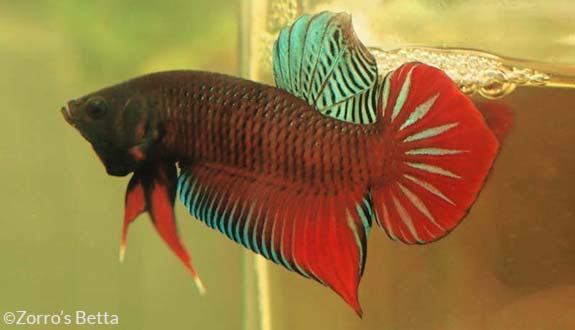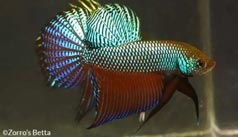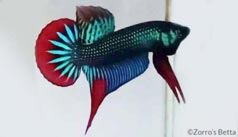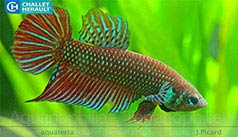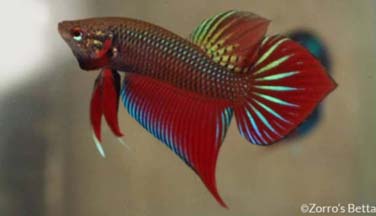

Alternative species (click on the thumbnail to see the card)
Names
Scientific name
Betta splendens (wild)
Micracanthus marchei
Betta splendens abbreviata
Common name
Siamese fighting fish (wild)
Siamesischer Kampffisch (De)
Origin

Origin: Thailand, Laos, India, Cambodge
Biotope: Asian
Dimorphism

The coloration of the male is more pronounced than that of the female. Its fins are also more developed.
Group

Osphronemidae
Volume

60 L / 13 imp gal / 16 US gal
Parameters

T°: 22 à 26°C or 72 to 79°F
pH: 5 to 7.5
Hardness: < 10°dGH
Difficulty

Average
Size

5.5 to 7 cm (2 to 3")
Longevity

5 to 7 years
Living zone
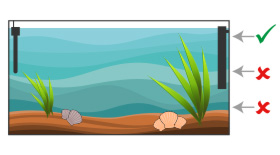
Top
Individuals

2
Food
How to feed the Wild Siamese fighting fish?
Food
How to feed the Wild Siamese fighting fish?
In general, Betta are mainly insectivorous, and by extension carnivorous. Unlike the variety selected and packaged for life in the aquarium, the wild Betta splendens will only feed on live or frozen prey. Traditional glitter or pellet type foods do not suit them.
You can base their diet with daphnids, mosquito larvae, asela and grammar. These small prey are ideal for the Betta because they cause neither digestive problems nor obesity.
To vary, occasionally distribute worms of vases, artemia or tubifex. Be careful though because they are fatty and heavy foods. They must therefore be offered twice a week at most!
Behavior
What kind of behavior does the Wild Siamese fighting fish have?
Behavior
What kind of behavior does the Wild Siamese fighting fish have?
It's pretty paradoxical, but the Betta are both shy, and at the same time territorial. Thus, even if the wild Betta splendens is generally peaceful, it can be aggressive with fish coming to bother them on their territory. This is especially true during the breeding season when the Betta will fiercely defend its nesting area.
Although less aggressive than the variety selected, wild Betta can be kept in groups. From 100 liters (22 Imp Gal or 26 US Gal), you can even keep several males in the same aquarium. It will then be necessary to add a group of female.
Cohabitation
Who can live with the Wild Siamese fighting fish?
Cohabitation
Who can live with the Wild Siamese fighting fish?
A suitable cohabitation is very reassuring for this fearful fish. Indeed, the presence of MicroFish like Danio margaritatus, Microdevario kubotai or Boraras for example is beneficial to the Betta. Indeed, this small group of serene and calm fish proves that there is no predator in the area!
Bottom species will also make good aquarium buddies for the Betta who live in the upper part of the aquarium. Choose preferably species from the same biotope: Asian. The kuhlii will for example could be a good choice.
Shrimp can also be kept in a Betta tank under two conditions: that the tank has enough hiding places (for example with very dense vegetation and roots) and that the shrimps are introduced before the fish.
Breeding
How to breed the Wild Siamese fighting fish?
Breeding
How to breed the Wild Siamese fighting fish?
You can achieve the breeding of wild Betta splendens with several methods depending on the desired yield. Spawning is quite easy to obtain but fry growth is more delicate.
Case number 1: you do not want to raise the young fish. Just leave them in the main aquarium with the other fish. Predation will be its job (some fry will still survive if the aquarium has a lot of hiding places and it is mature enough to provide microfauna that fry will feed on).
Case number 2: you can recover the young ones after hatching and put them in a breeding aquarium to preserve them from the predation of the other fishes. Some may be swallowed between hatching and your fishing.
Case number 3: Prepare a small breeding tank of about 30 liters (6 Imp Gal or 8 US Gal). It will contain fresh and acidic water, many plants that will be used for the visual isolation of the couple, surface plants that will be used as supports for the manufacture of bubble nest. There must be no current in this aquarium, so as to not destroy the fragile nest of bubbles. Install your male and female and let them live in this new environment.
When the male is ready to breed, it makes a nest of bubbles among the surface vegetation. Once finished, it goes for the love parade with the female (fast swimming, wriggling dance, beautiful colors...). The couple will position themselves under the nest to end up mating. The eggs are released in open water and fall to the ground. It is the male who will take care of collecting the eggs to gather them in the nest. Depending on its character, it can either chase the female, or accept its presence and why not its help. Be careful though, if you see that the male is too aggressive with the female, remove it from the aquarium to avoid damage. Once the eggs are collected, the male will take care of them: it monitors them, defends them and ventilates them. The nest that now contains the egg-laying becomes white and opaque.
At birth, small Bettas measure only a few millimeters and swim just below the surface of the water.
As for their diet, you will have to give them several small meals a day. The recommended foods are:
- microvers
- tubifex
- daphnies
- artemia nauplii (be careful because they can cause digestive problems because they are salty.
When the fry are 5/6 months old, you can feed them like adults.
The point of vigilance will focus on the formation of the labyrinth (complementary breathing organ common to all Osphronemidae). This delicate moment consists of the first air intake with this organ. If the ambient air is too far from the water, the small Betta may die. To avoid losses, cover and close the breeding tank as tightly as possible. This will limit the fatal air currents and harmonize the air/water temperatures. After this step, the young fish are no longer afraid and the end of their growth will not be a problem (except maintenance gap of course).
Its aquarium
Which aquarium for the Wild Siamese fighting fish?
Its aquarium
Which aquarium for the Wild Siamese fighting fish?
In the wild, these fish live in the stagnant waters of fields, flooded holes or pits and in ponds. You now understand why the first maintenance criteria is a very calm water, with almost no current, especially on the surface.
As far as decor is concerned, the Betta needs a lot of plants to feel at ease. Typically, install a thick layer of plant over the entire surface (mix of floating and Egeria, Cerato, Hydrocotyle that you will float) and cover the back of the aquarium with plants providing hiding places for other fish. Planting on the front may be lower, with Anubias or Microsorum on supports such as roots for example.
The technique of LowTech is therefore useful.
Good To know
Find all additional information!
Good To know
Find all additional information!
Do you know what Betta and Gourami have in common? A very original organ called the labyrinth. It is a complementary respiratory organ that they have developed because of the difficult living conditions to which they are subjected in their natural environment. Indeed, they live in stagnant waters with very little oxygen. When oxygen is too scarce in the water, they can breathe the ambient air on the surface.
Yours photos!
Comments
Sort by:
Please login to post comments
